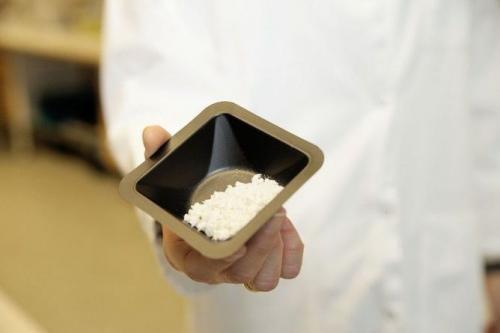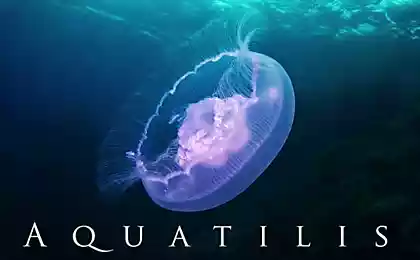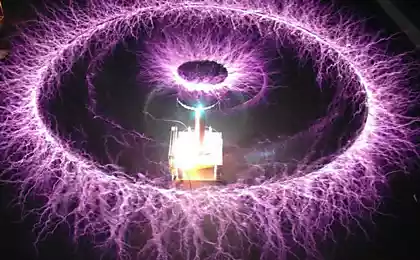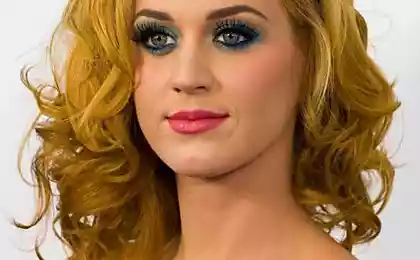878
The biggest successes of science in recent years (7 photos + video)
Science constantly moving forward and opens new horizons. In this post I will tell you about the most amazing achievements in recent
Cement, electrically conductive.

When it comes to good conductors cement certainly comes to mind. Scientists from the University of Alicante has recently invented cement, which has the ability to conduct heat and electricity effectively, without compromising its essential quality such as strength. While cement, electrically conductive, may not seem like a "magnificent scientific success," he has a huge potential for use in airports and on the roads, for example to prevent the formation of ice on the road surface. Not that cement may be used alone, it can also be applied as a coating on an existing one, to give him a thermal conductivity and electrical conductivity. This new cement contains carbon nanotubes, which give it strength and conductivity that are necessary. While the material showed good results in the multiple tests, developers continue to improve the conductivity and strength. Bose-Einstein condensate.

Satiendra Bose and Albert Einstein first hypothesized Bose-Einstein condensate back in the 1920s. Bose-Einstein condensate has an extremely low temperature, it can be said counterweight plasma that has extremely high temperature. While scientists have not yet been able to bring the velocity of the particle to the absolute zero, or a state in which no molecular motion, but they were able to produce the lowest temperatures right here on Earth. It was during one of these "deep frost" scientists were able to walk to practically zero (zero temperatures differed only ppb). Today, using rubidium atoms, scientists from Cornell and Veimen found that the interaction of the atoms form a group of "super atom." In fact, they are the first documented Bose-Einstein condensate. In fact, the molecules to stop time, but even more they were surprised that at the end of the atoms formed drop.
LiquiGlide.

At MIT invented a material to which nothing in the world simply can not stick. And they called his LiquiGlide. Fortunately, it is not toxic, and most importantly to him that nothing sticks while he was insanely slippery. It should be noted that even he had similar materials, but this first non-toxic material. Very cool to use it for shampoo, toothpaste, ketchup, of course only on the inside. Not only that, it can save companies money, eliminating the need to build costly specialized bottles, it also prevents the nervousness associated with attempts to squeeze the remnants of ketchup on your plate. It works with glass and plastic with a particular view. Companies are beginning to be interested in an amazing material, and it should appear in the bottles very soon.
Gas for Low Voice.
We have all heard of Helium, which at the time gives people a high voice, but have you ever heard of a gas that can make you sound like Darth Vader? Sulfur hexafluoride - an artificial structure with some pretty interesting and unique abilities. All this is due to the fact that it is - an incredibly dense and heavy particles. Not only that, you can inhale it and suddenly become Dzhigurda, you can resort to various objects and see how to use the gas as if they are floating in the air. Because of its weight, the speed of sound is considerably slowed down, trying to pass through the gas and making your voice becomes deeper. Also, this material falls to the bottom of the container and has a density allows the product to float on it. While it also has fun, and practical application, it is necessary to be careful, inhaling it, because he can sink to the bottom of your light and stay there.
Apsalit (Upsalite)

The most absorbent substance known to man, was invented ... by accident. Researchers at Uppsala University in Sweden accidentally left enabled equipment, and magnesium carbonate, with whom they worked, turned into a powder, with a surface area of 800 meters by only 1 gram. This highly porous material also has a very absorbent properties. The most expensive absorbent material used now - zeolite does not quite live up to the new in its absorbency and losing your mind at times. The material is of great importance for the control of humidity and oil business. Impressive stuff is light and surprisingly inexpensive. The pores covering the surface of the small Apsalita, less than 10 nanometers (nanometer - a billionth of a meter).
Nitinol (Nitinol).
If asked to describe the properties of memory metal and the elasticity of a word, you do not come to mind, if you have not heard of nitinol. Nitinol - the alloy of nickel and titanium, created back in 1958. Its properties exist in two phases. At low temperatures, the alloy can be deformed, but returns back into shape at high temperatures. This ability to return to its original shape is known as a thermal shape memory effect. Along with an incredible memory nitinol well known for its ability to be extremely useful because of its elasticity. Superelastic goes hand in hand with a thermal shape memory effect. Nitinol is very useful in industries that require a lot of flexibility. While most metals are known to break down after a continuous bending, nitinol, as proved almost immune to breaking under high voltage. From the time of his invention, it has been used in many industrial and technological products. Possibilities for this remarkable material continues to grow as the industry searching for materials which can memorize the shape, but continue to change.
Breathing through the liquid
This may seem like an idea of Start-fi movie, when people have the ability to breathe through the liquid using «Perfluorocarbons». What makes Perfluorocarbons so special? Its amazing capacity and ability to hold oxygen particles. While the normal air capacity 30 times higher than water at Perfluorocarbons it about 20 times greater than that of water. Before you will go to fill the pool Perfluorocarbonsom to safely swim for hours, it should be noted that it is used in medicine. They filled the space suits, to prevent problems such as nitrogen narcosis. It also helps to save the lives of premature babies or respiratory problems.
Self-cleaning clothes.

Tired wash clothes? Scientists have finally developed a material that can solve this problem. Using only sunlight, a special cotton material repels not only dirt but also pesticides. A student at the University of Davis did this by adding 2-anthraquinone carboxylic acid in cotton cloth, tied it with cellulose. It really works. While the self-cleaning clothes more expensive than might be expected, the researchers say that other chemicals, like it could work just as well, but at the same time are cheaper. Before you will go throw your washing machine, it is worth noting that you can not see the self-cleaning clothes on the shelves for a long time. Inventors look to more practical use of the invention in the armed forces or hospitals, where the purity of more vital.
Oxygen Injection.

David Blaine currently holds the world record for breath-hold as much as 17 minutes, but thanks to a new oxygen injection, anyone can easily hold their breath for 17 minutes or longer without any discomfort. Through scientific breakthrough, a new oxygen species, invented by the Boston Children's Hospital, people can be up to 30 minutes or more without breathing. Does this particle is so special is that it is surrounded by a membrane, which allows you to enter it directly into the bloodstream. After injection, the oxygen level in the blood can be returned to a completely normal within seconds. Particles unlike any oxygen particles invented previously, because they do not cause bubbles (embolism) after injection. Applications particles are endless.
Invisibility cloak.

Scientists have found a way to disguise themselves with the help of time. How does this happen? Scientists have found a way to control the speed of light, accelerating the front length of its waves and slowing the end of the fiber, so no one can see what you are doing. This essentially creates a small "hole" in space-time, where you can do what you want absolute silence. The idea has been mathematically proved as a possible back in 2010 (not including the Harry Potter movie) and has since been successfully developed. While the coat itself does not yet exist, scientists intend to weave the fiber as the usual stuff. He will have the ability to hide anything beneath it from everyone around you. The process occurs over 36 trillion seconds, and scientists continue to develop the technology.
Cement, electrically conductive.

When it comes to good conductors cement certainly comes to mind. Scientists from the University of Alicante has recently invented cement, which has the ability to conduct heat and electricity effectively, without compromising its essential quality such as strength. While cement, electrically conductive, may not seem like a "magnificent scientific success," he has a huge potential for use in airports and on the roads, for example to prevent the formation of ice on the road surface. Not that cement may be used alone, it can also be applied as a coating on an existing one, to give him a thermal conductivity and electrical conductivity. This new cement contains carbon nanotubes, which give it strength and conductivity that are necessary. While the material showed good results in the multiple tests, developers continue to improve the conductivity and strength. Bose-Einstein condensate.

Satiendra Bose and Albert Einstein first hypothesized Bose-Einstein condensate back in the 1920s. Bose-Einstein condensate has an extremely low temperature, it can be said counterweight plasma that has extremely high temperature. While scientists have not yet been able to bring the velocity of the particle to the absolute zero, or a state in which no molecular motion, but they were able to produce the lowest temperatures right here on Earth. It was during one of these "deep frost" scientists were able to walk to practically zero (zero temperatures differed only ppb). Today, using rubidium atoms, scientists from Cornell and Veimen found that the interaction of the atoms form a group of "super atom." In fact, they are the first documented Bose-Einstein condensate. In fact, the molecules to stop time, but even more they were surprised that at the end of the atoms formed drop.
LiquiGlide.

At MIT invented a material to which nothing in the world simply can not stick. And they called his LiquiGlide. Fortunately, it is not toxic, and most importantly to him that nothing sticks while he was insanely slippery. It should be noted that even he had similar materials, but this first non-toxic material. Very cool to use it for shampoo, toothpaste, ketchup, of course only on the inside. Not only that, it can save companies money, eliminating the need to build costly specialized bottles, it also prevents the nervousness associated with attempts to squeeze the remnants of ketchup on your plate. It works with glass and plastic with a particular view. Companies are beginning to be interested in an amazing material, and it should appear in the bottles very soon.
Gas for Low Voice.
We have all heard of Helium, which at the time gives people a high voice, but have you ever heard of a gas that can make you sound like Darth Vader? Sulfur hexafluoride - an artificial structure with some pretty interesting and unique abilities. All this is due to the fact that it is - an incredibly dense and heavy particles. Not only that, you can inhale it and suddenly become Dzhigurda, you can resort to various objects and see how to use the gas as if they are floating in the air. Because of its weight, the speed of sound is considerably slowed down, trying to pass through the gas and making your voice becomes deeper. Also, this material falls to the bottom of the container and has a density allows the product to float on it. While it also has fun, and practical application, it is necessary to be careful, inhaling it, because he can sink to the bottom of your light and stay there.
Apsalit (Upsalite)

The most absorbent substance known to man, was invented ... by accident. Researchers at Uppsala University in Sweden accidentally left enabled equipment, and magnesium carbonate, with whom they worked, turned into a powder, with a surface area of 800 meters by only 1 gram. This highly porous material also has a very absorbent properties. The most expensive absorbent material used now - zeolite does not quite live up to the new in its absorbency and losing your mind at times. The material is of great importance for the control of humidity and oil business. Impressive stuff is light and surprisingly inexpensive. The pores covering the surface of the small Apsalita, less than 10 nanometers (nanometer - a billionth of a meter).
Nitinol (Nitinol).
If asked to describe the properties of memory metal and the elasticity of a word, you do not come to mind, if you have not heard of nitinol. Nitinol - the alloy of nickel and titanium, created back in 1958. Its properties exist in two phases. At low temperatures, the alloy can be deformed, but returns back into shape at high temperatures. This ability to return to its original shape is known as a thermal shape memory effect. Along with an incredible memory nitinol well known for its ability to be extremely useful because of its elasticity. Superelastic goes hand in hand with a thermal shape memory effect. Nitinol is very useful in industries that require a lot of flexibility. While most metals are known to break down after a continuous bending, nitinol, as proved almost immune to breaking under high voltage. From the time of his invention, it has been used in many industrial and technological products. Possibilities for this remarkable material continues to grow as the industry searching for materials which can memorize the shape, but continue to change.
Breathing through the liquid
This may seem like an idea of Start-fi movie, when people have the ability to breathe through the liquid using «Perfluorocarbons». What makes Perfluorocarbons so special? Its amazing capacity and ability to hold oxygen particles. While the normal air capacity 30 times higher than water at Perfluorocarbons it about 20 times greater than that of water. Before you will go to fill the pool Perfluorocarbonsom to safely swim for hours, it should be noted that it is used in medicine. They filled the space suits, to prevent problems such as nitrogen narcosis. It also helps to save the lives of premature babies or respiratory problems.
Self-cleaning clothes.

Tired wash clothes? Scientists have finally developed a material that can solve this problem. Using only sunlight, a special cotton material repels not only dirt but also pesticides. A student at the University of Davis did this by adding 2-anthraquinone carboxylic acid in cotton cloth, tied it with cellulose. It really works. While the self-cleaning clothes more expensive than might be expected, the researchers say that other chemicals, like it could work just as well, but at the same time are cheaper. Before you will go throw your washing machine, it is worth noting that you can not see the self-cleaning clothes on the shelves for a long time. Inventors look to more practical use of the invention in the armed forces or hospitals, where the purity of more vital.
Oxygen Injection.

David Blaine currently holds the world record for breath-hold as much as 17 minutes, but thanks to a new oxygen injection, anyone can easily hold their breath for 17 minutes or longer without any discomfort. Through scientific breakthrough, a new oxygen species, invented by the Boston Children's Hospital, people can be up to 30 minutes or more without breathing. Does this particle is so special is that it is surrounded by a membrane, which allows you to enter it directly into the bloodstream. After injection, the oxygen level in the blood can be returned to a completely normal within seconds. Particles unlike any oxygen particles invented previously, because they do not cause bubbles (embolism) after injection. Applications particles are endless.
Invisibility cloak.

Scientists have found a way to disguise themselves with the help of time. How does this happen? Scientists have found a way to control the speed of light, accelerating the front length of its waves and slowing the end of the fiber, so no one can see what you are doing. This essentially creates a small "hole" in space-time, where you can do what you want absolute silence. The idea has been mathematically proved as a possible back in 2010 (not including the Harry Potter movie) and has since been successfully developed. While the coat itself does not yet exist, scientists intend to weave the fiber as the usual stuff. He will have the ability to hide anything beneath it from everyone around you. The process occurs over 36 trillion seconds, and scientists continue to develop the technology.























